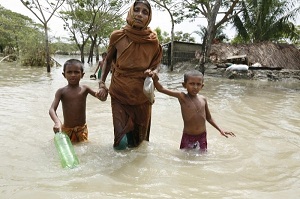Three Countries That Could Be Devastated By Warming-Fueled Hurricanes
 Hurricane Sandy’s assault on the Eastern United States should remind us that this could happen again. We rightly grieve for the storm’s victims and, if past is prologue, will generously contribute to helping them get back on their feet. This very American concern for suffering can also be motivator for working to prevent these sorts of storms in the future — that is, working to limit change as quickly as possible.
Hurricane Sandy’s assault on the Eastern United States should remind us that this could happen again. We rightly grieve for the storm’s victims and, if past is prologue, will generously contribute to helping them get back on their feet. This very American concern for suffering can also be motivator for working to prevent these sorts of storms in the future — that is, working to limit change as quickly as possible.Unchecked climate change will almost certainly result in more intense tropical storms and hurricanes — and rising seas – a combination that will be particularly deadly in these three places:
1. Bangladesh. Bangladesh was the site of the most deadly tropical cyclone in recorded history, Cyclone Bhola, which killed at least 500,000 people in 1970 despite only reaching Category Three strength. The country is so vulnerable to hurricanes as a consequence of its low, flat topography, relative poverty, and proximity to the ocean, which combine to produce devastating hurricane floods and limited ability to effectively prepare for them. Climate change, according to one model, is likely to increase the country’s vulnerable region by 67 percent by 2050, putting 9.1 million more people at risk from devastating floods and causing an estimated $5.5 billion in damages.
2. Indonesia. A recent study found that Indonesia’s capital, Jakarta, is the most sensitive — defined as “would be most destructive to its country if hit” — city in Southeast Asia to climate-change induced storms. That outpaces anywhere in Bangladesh, as Jakarta has an an enormous population and is responsible for 20 percent of Indonesian GDP, meaning that a significant storm hitting the capital could cause immense damage. Indeed, the island country as a whole is quite vulnerable to extreme weather and flooding, as the horrific 2004 tsunami proved. A 2010 retread was far less destructive, but suggested the country was still vulnerable to extreme weather.
3. Haiti. A 2008 hurricane killed hundreds and destroyed 60 percent of the crops in the extremely poor Caribbean country, underscoring the already hurricane-prone country’s vulnerability to climate change-induced storms. And the effects of severe storms on the country could be more long-term than generally thought. According to Madeleine Rubinstein, the Research Coordinator for the Columbia University Climate Center, “More frequent and more intense storms and rainfalls could harm Haiti’s food supply, as serious erosion and poor soil health lead to decreased livestock and crop productivity.”
These three countries are the tip of the iceberg. A recent study by the consulting group Maplecroft found that 30 countries were at “extreme risk” from the environmental consequences of climate change. For this reason, Harvard economist Dani Rodrik believes that reducing carbon emissions is one of the most effective avenues for addressing global poverty available to Western policymakers.
You can return to the main Market News page, or press the Back button on your browser.

